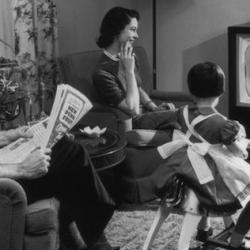In an intriguing TNR review of Walter Isaacson’s Steve Jobs , Evgeny Morozov says that the Apple “philosophy” – a form of pop-Platonism emphasizing the link between “essence” and function, purity, unornamented sleekness – cannot be understood except as an expression of a modernist design aesthetic most famously embodied in Bauhaus architecture. Morozov writes in part:
“In addition to its minimalism, the Bauhaus also championed an obsession with functionalism—the idea, revolutionary in its time, that form follows function. The Bauhaus enthusiasm for ‘function’ is the precursor of Apple’s enthusiasm for ‘essence.; But how did the Bauhaus designers and architects explain the functions of their products and structures? Where did they come from, and how were they discovered? In a superb essay, in 1995, on the question of why the notion of ‘form follows function’ was so attractive to the Bauhaus, the design historian Jan Michl observed that, instead of appealing to religious deities or nature to justify the product’s functions, modernist designers appealed to something abstract and objective: the spirit of the times . . . .
“‘Functionalists proper,’ Michl writes, ‘those of the 1920s and 1930s, did not refer to God but rather to demands of the ‘Zeitgeist’, ‘Modern Epoch’, or ‘Machine Age.” . . . They referred to Purposes of an other-than-human Intelligence. Such Purposes, in not being human purposes, were allegedly no longer subjective but objective, and as such they sanctioned the vision of objective design.’ Writing in 1926, Gropius, director of the Bauhaus at the time, proclaimed that ‘the Bauhaus seeks—by the means of systematic theoretical and practical research into formal, technical and economic fields—to derive the form of an object from its natural functions and limitations.’
In short, “The task of the designer . . . was not to please or to innovate. It was to uncover and to reveal—rather like scientists; for design is just a tangible, natural, and objective byproduct of history. As Michl put it, ‘Functional forms do not simply appeal to taste, because they are a matter of truth—and truth does not pander to taste.’ It is no wonder that the functionalists loved to tout the supposed timelessness of their forms: truth, after all, has only one timeless form, or so many members of the Bauhaus believed. (That the modern epoch may eventually come to an end and be followed by an epoch with a different set of values and needs did not occur to them.) It’s no wonder that the highest compliment that Jony Ive could bestow on Dieter Rams was to call the design of his products ‘inevitable.’”
This gave architects the sense that they were a higher breed than commercial, consumer-driven architects, and this same aspiration to transcend the market is evident in Apple: “Functionalism gave modernist designers the illusion of working outside of the crass realities of the commercial marketplace—they were in the truth-seeking business, after all—while also infusing them with a sense of autonomy that elevated them to the ranks of poets and artists: they were no longer mere instruments in the hands of big business. And functionalism had something to offer their customers as well. In pretending that they did not exist, functionalism, paradoxically, elevated the customers to a kind of priestly status. In what is probably the best explanation of Apple’s astonishing appeal to consumers, Michl notes about the Bauhaus’s ideology that ‘to be defined as a user worthy of the functionalist architect’s attention one had first to qualify as Modern Man, i.e., a person whose likes and dislikes were practically identical to those of the modernist architect himself. The functionalist references to users never suggested a readiness to consider the users’ wishes, demands, and needs on their own merits. The individual client, who until the arrival of modernism was thought to have a legitimate say in both functional and aesthetic matters, was now on his way to becoming an unperson. This was only logical: since forms were claimed to be intrinsic to functional solutions, there was no reason to take the form- or function-related preferences of clients and users seriously.’”
This explains, Morozov thinks, the religious devotion of Apple’s customers, and their sense that in buying Apple they are engaging in a revolutionary act, taking a bite from the fruit of knowledge: “No wonder that the counterculture fizzled in the early 1980s: everyone was promised they could change the world by buying a Macintosh. Linking Apple to the historical process (Hegel comes to Palo Alto!), and convincing the marketplace that the company always represented the good side in any conflict, broke new ground in promotional creativity. Jobs turned to the power of culture to sell his products. He was a marketing genius because he was always appealing to the meaning of life. With its first batch of computers, Apple successfully appropriated the theme of the decentralization of power in technology—then also present in the deep ecology and appropriate technology movements—that was so dear to the New Left a decade earlier. If people were longing for technology that was small and beautiful—to borrow E.F. Schumacher’s then-popular slogan—Jobs would give it to them. Apple allowed people who had missed all the important fights of their era to participate in a battle of their own—a battle for progress, humanity, innovation. And it was a battle that was to be won in the stores.”
Apple executives were very self-conscious about this: “As Apple’s marketing director in the early 1980s told Esquire , ‘We all felt as though we had missed the civil rights movement. We had missed Vietnam. What we had was the Macintosh.’”
Morozov sums up: “The consumer as revolutionary: it was altogether brilliant, and of course a terrible delusion.”











